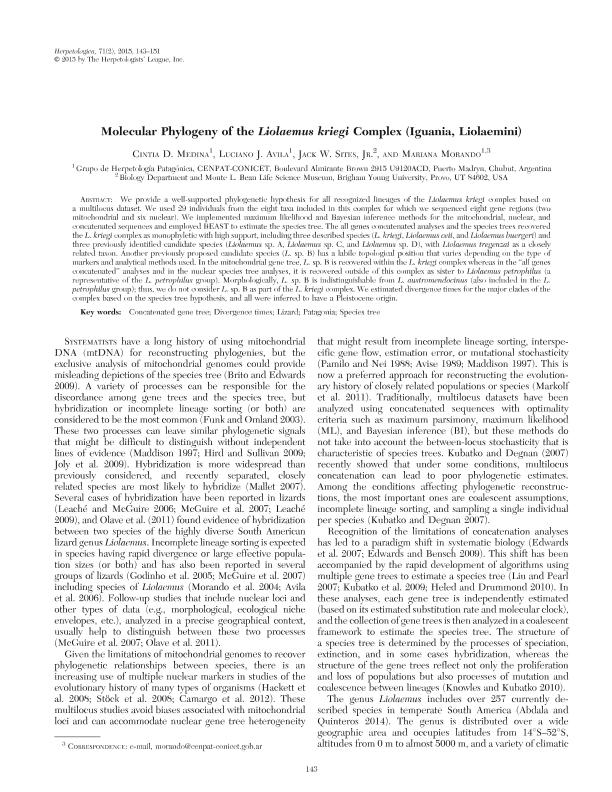Mostrar el registro sencillo del ítem
dc.contributor.author
Medina, Cintia Débora

dc.contributor.author
Avila, Luciano Javier

dc.contributor.author
Sites, Jack W.
dc.contributor.author
Morando, Mariana

dc.date.available
2018-02-23T20:18:32Z
dc.date.issued
2015-06
dc.identifier.citation
Medina, Cintia Débora; Avila, Luciano Javier; Sites, Jack W.; Morando, Mariana; Molecular phylogeny of the liolaemus kriegi complex (Iguania, Liolaemini); Herpetologists League; Herpetologica; 71; 2; 6-2015; 143-151
dc.identifier.issn
0018-0831
dc.identifier.uri
http://hdl.handle.net/11336/37064
dc.description.abstract
We provide a well-supported phylogenetic hypothesis for all recognized lineages of the Liolaemus kriegi complex based on a multilocus dataset. We used 29 individuals from the eight taxa included in this complex for which we sequenced eight gene regions (two mitochondrial and six nuclear). We implemented maximum likelihood and Bayesian inference methods for the mitochondrial, nuclear, and concatenated sequences and employed BEAST to estimate the species tree. The all genes concatenated analyses and the species trees recovered the L. kriegi complex as monophyletic with high support, including three described species (L. kriegi, Liolaemus ceii, and Liolaemus buergeri) and three previously identified candidate species (Liolaemus sp. A, Liolaemus sp. C, and Liolaemus sp. D), with Liolaemus tregenzai as a closely related taxon. Another previously proposed candidate species (L. sp. B) has a labile topological position that varies depending on the type of markers and analytical methods used. In the mitochondrial gene tree, L. sp. B is recovered within the L. kriegi complex whereas in the "all genes concatenated" analyses and in the nuclear species tree analyses, it is recovered outside of this complex as sister to Liolaemus petrophilus (a representative of the L. petrophilus group). Morphologically, L. sp. B is indistinguishable from L. austromendocinus (also included in the L. petrophilus group); thus, we do not consider L. sp. B as part of the L. kriegi complex. We estimated divergence times for the major clades of the complex based on the species tree hypothesis, and all were inferred to have a Pleistocene origin.
dc.format
application/pdf
dc.language.iso
eng
dc.publisher
Herpetologists League

dc.rights
info:eu-repo/semantics/openAccess
dc.rights.uri
https://creativecommons.org/licenses/by-nc-sa/2.5/ar/
dc.subject
Concatenated Gene Tree
dc.subject
Divergence Times
dc.subject
Lizard
dc.subject
Patagonia
dc.subject
Species Tree
dc.subject.classification
Otras Ciencias Biológicas

dc.subject.classification
Ciencias Biológicas

dc.subject.classification
CIENCIAS NATURALES Y EXACTAS

dc.title
Molecular phylogeny of the liolaemus kriegi complex (Iguania, Liolaemini)
dc.type
info:eu-repo/semantics/article
dc.type
info:ar-repo/semantics/artículo
dc.type
info:eu-repo/semantics/publishedVersion
dc.date.updated
2018-02-20T17:10:16Z
dc.journal.volume
71
dc.journal.number
2
dc.journal.pagination
143-151
dc.journal.pais
Estados Unidos

dc.journal.ciudad
Lawrence
dc.description.fil
Fil: Medina, Cintia Débora. Consejo Nacional de Investigaciones Científicas y Técnicas. Centro Nacional Patagónico; Argentina
dc.description.fil
Fil: Avila, Luciano Javier. Consejo Nacional de Investigaciones Científicas y Técnicas. Centro Nacional Patagónico; Argentina
dc.description.fil
Fil: Sites, Jack W.. University Brigham Young; Estados Unidos
dc.description.fil
Fil: Morando, Mariana. Consejo Nacional de Investigaciones Científicas y Técnicas. Centro Nacional Patagónico; Argentina
dc.journal.title
Herpetologica

dc.relation.alternativeid
info:eu-repo/semantics/altIdentifier/url/http://www.bioone.org/doi/10.1655/HERPETOLOGICA-D-13-00083
dc.relation.alternativeid
info:eu-repo/semantics/altIdentifier/doi/https://doi.org/10.1655/HERPETOLOGICA-D-13-00083
Archivos asociados
